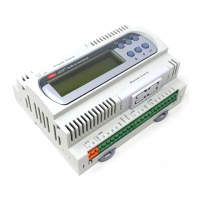pCO Sistema
Code: +030220336 - rel. 1.5 - 22/12/10
56
7.1.1
7.1.17.1.1
7.1.1 Commissioning Tool
Commissioning ToolCommissioning Tool
Commissioning Tool
Settings required to use the Commissioning Tool
Settings on the pCO for using the Commissioning Tool:
1) the application must feature a screen used to set the Winload protocol on the serial port where the PC with the Commissioning Tool is connected.
Otherwise, there must be another possible procedure for selecting the protocol (e.g. from supervisor).
2) In the remote connection correctly set the system variables relating to the PSTN or GSM modem.
3) To run the operations made available with the commissioning tool, connect when the application is already running; this means that procedures must be
available for setting in advance (screen in the application or supervisor) the Winload protocol after that the pCO has been powered up. If the pCO is
directly connected via pLAN serial on power-up, it enters Winload mode and the operations relating to the commissioning tool cannot be managed.
4) If the firmware and the application are updated, the pCO must be reset before being able to use the Commissioning Tool.
5) Once the protocol has been set correctly on the desired serial port, the PC can be connected. IMPORTANT: if using the BMS or FIELDBUS serial port, once
the pCO is disconnected by command from the PC (for example, when switching from the PCOLOAD window to the Commissioning Tool window and
vice-versa) the pCO restores the protocol that was previously set on the serial port in question. If the application was previously updated, on the other
hand, the pCO is automatically reset. To reconnect the pCO in these cases, restore the Winload protocol on the pCO.
Memory limits:
Memory limits:Memory limits:
Memory limits:
The periodical monitoring of the variables in the application is limited to a maximum of 250 WORDS, which can be defined as desired from the entire memory
available to the application. The application variable virtualisation function is limited to a maximum of 50 WORDS, which can be defined as desired from the entire
memory available to the application.
There are no address setting limits to writing and reading the individual “one-shot” variables: all the memory addresses reserved for the application are available, in all
types of memory on the pCO: X memory, T memory, P memory, E memory.
7.2 Smart Key
The new SMARTKEY programming key is used to emulate the operation of the parallel programming key on the models of pCO where this is not available (pCO
XS
,
pCO
3
), with the exception of the BOOT, which is not loaded by the SMARTKEY. Specifically, the key can clone the contents of a pCO and then download these to
another identical pCO using the telephone connector on the terminals (the pLAN must be disconnected). This function is obviously available for all the pCO
controllers, even those with the parallel key. As well as this mode, the key can also copy the logged data from a series of pCO controllers and then copy the data to a
PC.
Using a PC running the “SMARTKEY PROGRAMMER”, the key can be configured to run certain operations: copy logs, program applications, program the Bios, etc.
For further details, see the online help in the “SMARTKEY PROGRAMMER” and the SMARTKEY instruction sheet.
7.3 NAND FLASH memory
This type of memory is only available on the pCO3 versions with codes pCO3 * * * C/D/F/G/H/I * *.
Using Winload version 3.37 and the new pCOLOAD routine in the pCOMANAGER program, any type of file can be loaded into the NAND FLASH memory, for example,
source files of the application on the unit.
As well as this function, the IUP, BLB (or BIN) and DEV files, representing the files of parameters, the screens to be displayed in the various languages and the control
logic, can also be loaded to the NAND flash and then selected from a screen on the terminal to be used as the current application on the pCO. This means that
multiple applications, or multiple languages, or alternatively multiple parameter files can be loaded to the NAND flash memory and then the desired application,
language or set of parameters can be selected and loaded to main flash memory. The files in NAND flash memory can be selected for copying the main flash from a
screen managed directly by the Bios. The procedure is described in the following paragraph.
Limits:
Limits:Limits:
Limits:
• Currently (Bios 4.01) the number of files that can be saved to NAND flash memory is limited to 40.
• The NAND flash memory can only be updated using the local Winload connection and via pLAN serial.
• The maximum overall capacity of the memory is in any case limited to 32 Mbytes.
7.4 Checking the software installed on the pCO and other information
The current program version can be checked at any time (CRC code expressed in hexadecimal format), as well as whether this is run from the key or resident. To do
this, simply proceed as described below.
7.4.1
7.4.17.4.1
7.4.1 Screens managed by the BIOS
Screens managed by the BIOSScreens managed by the BIOS
Screens managed by the BIOS
Press the ALARM and ENTER buttons together for 3 seconds to display the following screen.

